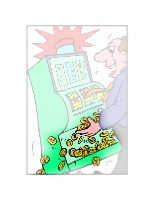Technology is advancing so quickly that there is a risk customers will not accept it or, at least, not like it.
My wife and I were in a casino recently playing the slot machines for fun (certainly not for profit!). The devices, of course, were electronic and took cash, magnetic cards or casino-approved receipts in order to play and when we cashed out, the machines gave us a bar-coded receipt with the dollar total, which was playable throughout the casino. As the cash-out transaction was printing, however, the machine produced the sound of coins or casino tokens hitting the metal catch bin, when the slot machine was simply printing a paper receipt with a bar code and dollar amount. I smiled when I heard the non-existent coins drop into the bin. I knew they weren't really there, of course, but the sound made my experience fun and I mentally gave the manufacturer credit for a large amount of creativity.
There is a word for that process. A skeuomorph is a design feature copied from a similar object in another material, even when not functionally necessary. Great thanks to Anu Garg and his awesome website www.wordsmith.org for this information. As products evolve, it is important for the designer to ensure that the customer is comfortable with the difference and accepts the new feature or technology as a logical improvement rather than a drastic change. Keeping a feature, such as the sound of coins dropping on metal that was prominent in older slot machines, helps the customer adapt to the new process and "entertains" customers instead of forcing them to wait during the printing time.
There are more skeuomorph examples than you might expect at first. Every one of these reflects the willingness of the designer and manufacturer to consider the customer's need to feel comfortable with new configurations and technology:
- A copper-colored U.S. penny, even though coins are made from a zinc alloy and contain no copper, or steel cladding over copper U.S. quarters
- The clicking sound of a digital camera, in imitation of film being forwarded, to indicate that a shot has been completed.
- Wood finish on a plastic product.
- Denim jeans with non-functional rivets.
- Metered postage showing wavy lines and circular town symbols in the style of old-fashioned cancellation marks.
- Automobiles with landau roofs to resemble the style of horse-drawn carriages.
- Audio software with graphics simulating old-fashioned stereo equipment.
Nicholas Gessler at www.skeuomorph.com refers to these as material metaphors. They are brilliant in their simplicity. The simulation of attributes that look or sound like things we already know helps us register new items in our cognitive systems. We are more willing to accept the product into our belief space because we can identify with the process or appearance. Honestly, as customers, don't we really do that with everything we purchase and every brand that we recognize?
It is human nature to experience some resistance to new products, as we "cling to the maps" we are familiar with, as Gessler writes. Maintaining some resemblance to the product being replaced helps break down those barriers enough to give customers a comfort level, with one foot in the past, so to speak, as they become used to the newer version.
Developers are more successful if they stay in touch with customers' needs. Keeping things familiar, such as designing audio software with a look and feel of regular stereo equipment, in order to give the user a feeling of comfort and authenticity. Products which solve customers' problems still need those customers to be comfortable enough to buy and use the product. And this comfort comes through a seller's dynamic understanding of the customer's expectations. The customer will have more confidence in using the innovation if he or she can relate the newer version to a similar experience in the past.
The skeuomorphy process is a fantastic, but sensible, way to show customers that you are in touch with their needs. Playing the role of experts, designers and manufacturers must own the process completely and anticipate their customers' needs through strong attention to detail. The more they successfully take on the role of trusted advisor, the more customers will depend on them (in a positive way). If you can help your customers understand advancements in terms of what is old and familiar, then your organization is truly thinking like a customer.
